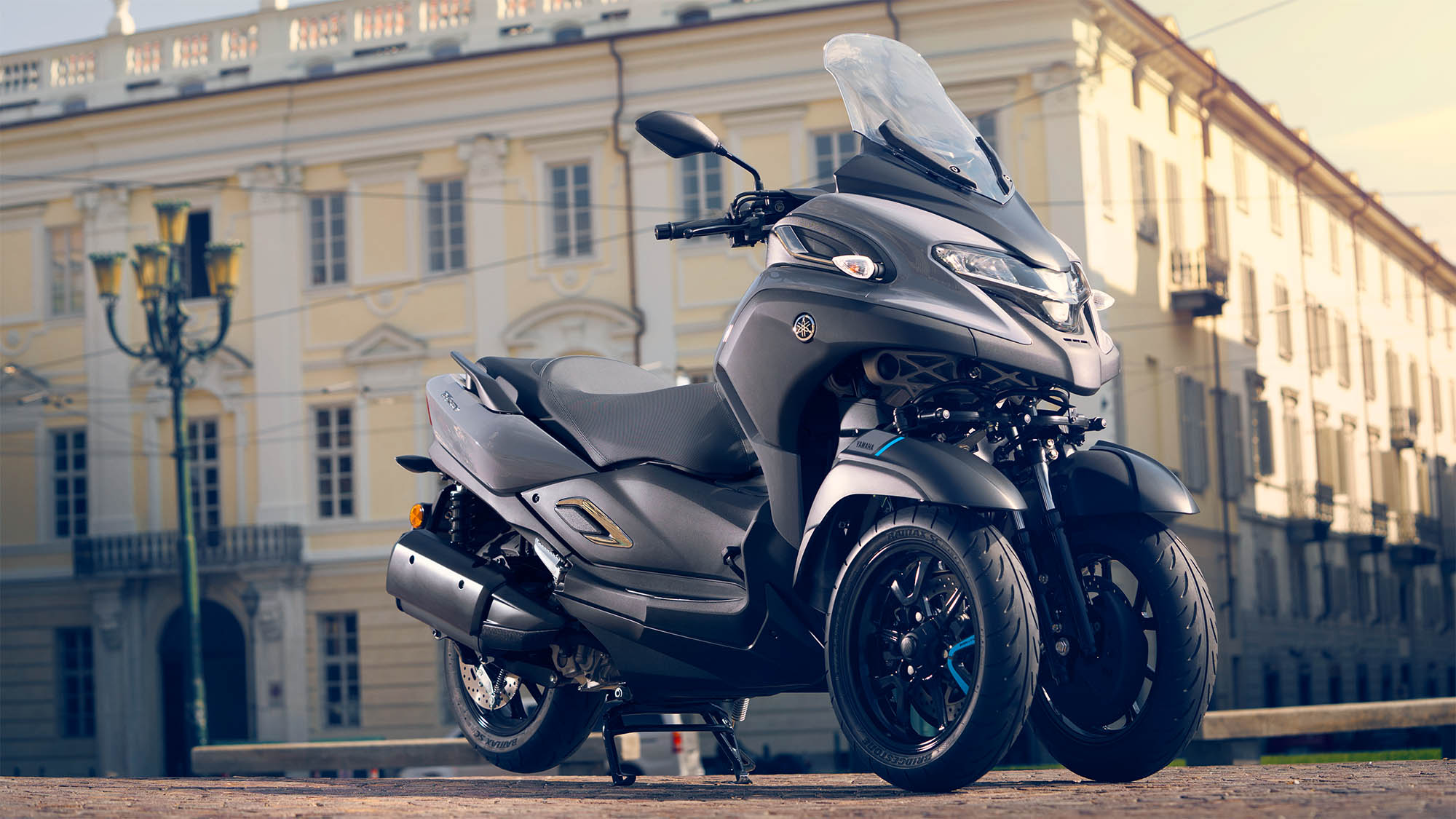The biggest appeal is the simplicity in which people can make the transition from driving or taking the train, to riding. If you’re a car driver, there’s no need to go through today’s baffling bike licence maze to enable you to legally ride one. All you need is a full car licence, and away you go. The reason being is that, unlike the other two three-wheelers in Yamaha’s range, the Tricity 125 and the 845cc Niken, the Tricity 300 is in fact classed as a trike, due to the ‘track’ (the distance between the two front wheels) being beyond a certain width to fit into the trike classification.
Of course, Yamaha isn’t the only manufacturer to try and tap into this market. Piaggio, with the MP3, and Peugeot’s Metropolis have had some success on the continent in recent years, but Yamaha has been refining its three-wheeled technology in recent years and becomes the first mainstream motorcycle player to take on this potentially bourgeoning sector.
It’s the ease with which almost anyone can start riding the Tricity makes it arguably the most important ‘motorbike’ of 2020. So, what’s it like to ride?
The 2020 Yamaha Tricity 300 rides like a conventional scooter
Although the Tricity 300 can be ridden without any prior motorcycle training whatsoever (which we don’t recommend), it still rides like a conventional two-wheeled scooter, but with the added front-end confidence thanks to that extra wheel, especially in sketchy conditions. It’s a twist-and-go, it leans when you ride round corners and reacts accordingly to rider input, and you do still have to put your feet down when you stop. Unless you lock the Leaning Multi Wheel (LMW) system using the handy ‘Standing Assist’ button on the left hand switch gear.
With an additional front wheel comes some additional parts to make the steering work. Look at the Tricity from the bottom up, and you’ll find four fork legs, two on each front wheel, which lead to a steering rack keeping both wheels pointing in the same direction. Above the rack are a pair of big horizontal links that ensures everything is lined up when leant over. It’s confusing, but it works.
These extra parts give a slightly disconnected feeling through the handlebars but having two front wheels provides reassurance in a way that an orthodox scooter could never match. Perfect for people new to riding, then? One thing to watch out for, though, is that being a three-wheeler, naturally none of the wheels are in line meaning avoiding potholes and other road debris becomes three times harder.
Like a standard two-wheeled scooter, the brake levers are in the same place as on a bicycle, but there is a slight difference considering the third wheel that’s thrown into the mix. The right hand lever operates the brakes on the front two wheels only, with the left hand lever operating both the front and rear brakes. Alternatively, there’s a foot pedal close to your right foot, which also activates all three brakes.
The 2020 Yamaha Tricity 300 is practical, too
Considering that the Tricity 300 is essentially aimed at non-bikers, its levels of practicality has to compete with cars and public transport. The seat is nice and wide and fairly tall, making it very comfortable, but those who have ridden smaller scooters before will immediately be drawn to the bulk. There’s a lot of bodywork that covers the front wheels’ tilting mechanism, but that takes minutes to get used to, and more importantly it’s not intimidating or detrimental to the ride.
The mass of bodywork should make non-bikers feel more at home, giving the rider a bigger presence and more visible to other traffic. And it’s not too wide to filter through grid locked traffic either, with the handlebars still the widest point on the bike at just 4cm wider than the XMax 300, the closest two-wheeled equivalent in Yamaha’s range.
Although the Tricity 300 is a whopping 60kg heavier than the XMax with which it shares the same 292cc, four-valve, water-cooled, single-cylinder engine, the Tricity will sit at between 60mph and 70mph on the open road with ease. The power to weight ratio is down on the XMax of course, and the aerodynamics are not as good, but in reality the three-wheeler has enough poke for around town and short motorway stints, making light work of most commutes.
It also has enormous under-seat storage that can comfortably fit two full-face helmets or one full-face helmet and a bag or lock etcetera, with the compartment luminated with an internal LED light. Other standard features include ‘Smart Key’ operation, ABS and Traction Control, as well as easy-to-read LCD instruments and even a parking brake.
2020 Yamaha Tricity 300 verdict
Priced at £7,399, it’s not the cheapest scooter in the world. But there are many reasons to swap crowded trains, buses, and driving your car into work for the convenience and cost effectiveness of a scooter. And Yamaha have made the Tricity 300 even more convenient thanks to its trike status avoiding the need for any kind of motorcycle training or licence.
That said, the Tricity’s characteristics are unquestionably ‘motorcycle’, so jumping on one with no prior knowledge of riding a scooter, moped or bigger machine, isn’t advisable. If you’re considering making the switch, enrol on a CBT (compulsory basic training) – it’s cheap and only takes a day, and it will improve your confidence no end. If you fancy something a bit cheaper and lighter, and don’t need the extra performance for the open road, Yamaha’s £4024 Tricity 125 is also available. This can’t be ridden directly on a car licence, but as a 125cc it’s still very accessible and can be legally ridden on a provisional.
Overall, the Tricity 300 offers the easiest route into motorcycling for many commuters. It’s an impressive machine that delivers usable performance and will do everything you need and more as a way to get you to from A to B. You won’t regret it.



